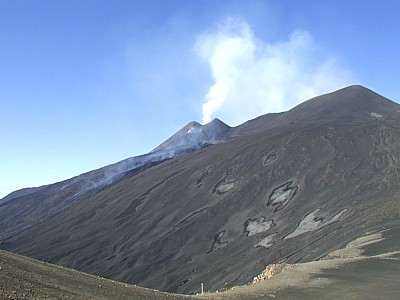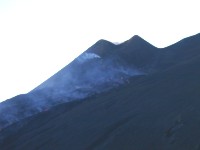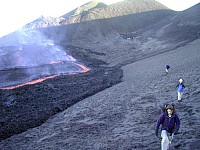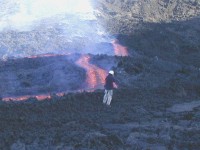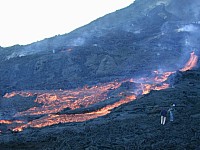|
WARNING:
Access to the summit area is VERY
DANGEROUS and ACCESS TO THE SUMMIT CRATERS IS FORBIDDEN.
The regime of eruptive activity at the Southeast Crater has
changed once more, and episodes of vigorous explosive and effusive
activity might occur with relatively little warning. Guided
excursions on the south flank that end at the Torre del Filosofo,
at about 2900 m elevation, have resumed in mid-March, and on
the north flank excursions arrive at 3100 m elevation, on the
E side of the main summit cone. Tourists
should make excursions only with the mountain guides and NEVER
GO ALONE, even though this will not satisfy the wish
to see what's going on at close range. Besides this, weather
conditions are often unstable: strong wind, snow or rain and
clouds are occuring frequently in the summit area, even during
the summer, and one can get easily lost. The mountain guides
can be contacted at the cable car (near the Rifugio Sapienza)
on the southern side of Etna (phone: 095-914141), or (during
the summer) at the hotel "Le Betulle" at Piano Provenzana,
on the northern side (phone: 095-643430). There
is now a new web site giving more information about guided excursions
on Etna.
|
Do you look for books or videos about
volcanoes, volcanology, or in particular Mount Etna? Find and buy
them at Amazon.com!
This
ad helps to keep this site alive
The
latest update is near the bottom of this page
13 June 2001 update.
The fourth
eruptive episode in a week occurred at the Southeast Crater on the
early morning of 13 June. It was stronger and lasted longer than its
three predecessors and thus followed the trend, observed earlier,
toward more and more powerful eruptive episodes.
Due to timely information received from Giuseppe Scarpinati (Italian
delegate of the Paris-based Association
Volcanologique Européenne, or "L.A.V.E."), it
was possible to react swiftly and move to an observation point that
offers a panoramic view of the eastern flank of Etna, the "Mareneve"
road near the village of Fornazzo, about 6 km from the Southeast Crater.
Observations were made by Boris Behncke, Christopher Crozet, Claudia
Pirotta and Sebastiano Tarascio (Dipartimento di Scienze Geologiche,
University of Catania),
who were accompanied by Humphrey Reader from the U.K.
Lava extrusion from the vent (or cone) on the NNE flank of the SE
Crater cone was first observed by Scarpinati at about 2130 h (local
time=GMT+2) from his home in Acireale. About one hour later, Behncke
and his companions left Catania for Fornazzo, where they arrived at
about 2330 h. By this time, the activity was still at fairly low levels,
with a lava flow extending about 400-500 m toward NE from the active
vent, which was glowing brightly, and very weak, seep-seated Strombolian
bursts at the summit vent of the SE Crater that occurred at intervals
of 2-8 minutes.
For the next three hours, the progress of the eruptive activity was
agonizingly slow. The first lava flow eventually waned, then the glow
at the NNE flank vent intensified, and a fresh surge of lava began
to advande on top of the earlier flow lobe. Strombolian activity at
the summit vent of the SE Crater also fluctuated repeatedly over the
hours. At times, when the summit vent activity increased, the NNE
flank vent would become nearly inactive, remain so for up to 15 minutes,
then a bright glow would reappear at that vent, while the summit vent
became less vigorous. For quite some time the activity showed no clear
increasing trend. Only at about 0300 h the NNE flank vent dramatically
increased its activity, and the first jets of fluid lava were seen
gushing 10-20 m high above its crest. At 0310 h, a large magma bubble
exploded in the same vent, sending large blobs of fluid lava over
much of the cone that has built around the vent during the latest
eruptive episodes. By 0315 h, lava was jetting continuously to heights
of 30-50 m, but at the same time the SE Crater summit vent still produced
only sporadic Strombolian bursts, and incandescent ejecta rarely rose
above its rim.
Then, at around 0345 h, activity at the summit vent began to increase
rapidly. Explosions now occurred about once per second, and glowing
bombs not only rose up to 100 m above the rim, but many of them fell
onto the upper flanks of the SE Crater cone. Yet, at this time, there
was very little sound audible at the "Mareneve" observation
post.
During the following 30 minutes or so, activity at both vents continued
to increase; by 0405 h, lava fountains from the NNE flank vent rose
150-200 m high, and at the summit vent, Strombolian bursts were now
occurring so frequently that they eventually blended into one continuous,
pulsating fountain up to 400 high. Some bursts sent bombs even to
about 500 m above the rim. Much of the SE Crater cone was covered
with incandescent ejecta. Ash was emitted with many of the stronger
bursts, but on a whole, tephra generation was relatively modest in
spite of the violence of the activity. Loud roaring noises, punctuated
by impressive detonations and atmospheric pressure waves, were now
audible; all of them came from the summit vent. At the same time,
a slight rise in the air temperature was noted at the observation
post.
From 0425 h on, the NNE flank vent gradually lost its vigor, the fountain
here decreased in height and then became intermittent. Strong activity
continued at the summit vent for another 15-20 minutes and then also
became intermittent, although the eruption sounds were now louder
than at any time before.
Similarly to the remarkably slow and by no means linear buildup, the
waning phase also extended over 1 hour and was interrupted repeatedly
by brief and violent resurgences of the summit vent activity. Supply
to the lava flow had stopped; a multilobate flow front stagnated about
1.3 km from the source vent. By 0600 h the activity was practically
over, more than 7 hours after Behncke and his companions had left
Catania. The last eruptive manifestations occurred at about 0620 h,
when several loud explosions sent ash plumes a few hundred meters
above the summit vent of the SE Crater.
This latest paroxysm occurred once more after a quiet interval of
about 2 days (precisely, the interval was about 44 hours). The SE
Crater has thus established a fairly regular eruptive behavior, but
it is evident that each new eruptive episode is stronger than its
predecessor. It is not possible to say whether this trend will continue;
however, more eruptive episodes are likely to occur in the near future.
14 June 2001 update.
No eruptive
activity has been observed at the Southeast Crater since its latest
paroxysmal eruptive episode on the early morning of 13 June, but if
the crater maintains the same rhythm as in the past week, another
eruptive episode might occur within the next 24 hours. The next paroxysm
might be as strong as (or even stronger than) the previous one, but
will not present any threat to inhabited or cultivated areas.
15 June 2001 update.
This update
is posted at 1300 h (local time=GMT+2) on 15 June. At this moment,
another eruptive episode is under way at the Southeast Crater, the
fifth in 8 days, and it is occurring within the time window indicated
in the previous (14 June) update. Preliminary information comes from
Giuseppe Scarpinati (Italian delegate of the Paris-based Association
Volcanologique Européenne, or "L.A.V.E."), who
is observing the event from the Pizzi Deneri area.
Lava began to issue from the small cone on the NNE flank of the Southeast
Crater cone sometime after midnight; by 0900 h the first spatter ejections
were observed at the same vent, and at about noon the activity reached
its culminating phase. As of 1300 h, strong explosive activity was
still occurring, while Scarpinati and others were attempting to obtain
a closer view of the event. From Catania, a dense gas plume is visible,
but hazy weather makes direct observation of the activity from here
almost impossible. More detail will be posted at the end of this month,
including a summary of the activity which will occur during my absence.
Several
other web pages covering the recent and ongoing eruptions of the Southeast
Crater are now available; these contain photos and movie clips of
some of the most spectacular moments of that period.
Etna
in 2000 - a list of all paroxysms at the SE Crater since 26 January
and photos (this site)
Etna
in 2000 - various pages at Stromboli On-line with photos and movie
clips of SE Crater paroxysms and Bocca Nuova gas rings: most photos
are of Marco Fulle, the artist photographer among us
Extremely
spectacular video clips, taken by British cameraman and film maker
David Bryant on 15 February 2000
At
"Italy's Volcanoes" -
At Stromboli On-line
An
interview with Boris Behncke, made in late February 2000 by a BBC
team
and a video
clip (RealPlayer)
Photos
of the eruptive activity, 15-23 February 2000, by Tom Pfeiffer (University
of Arhus, Denmark) - scroll to bottom of page
Alain
Catté (Association Volcanologique Européenne) has photos
of Etna
from many years
Photos
of an eruptive episode on 13 February 2000, posted on the web site
of the Association Volcanologique Européenne, Paris, France
Thorsten
Boeckel's web site (Germany) with photos and movie clips of several
paroxysm of the SE Crater in February, April and June 2000
A
small web page reporting on Etna's current activity - and check what
happens to your cursor on that page...
Charles
Rivière's Etna home page, with many photos and video clips
(the most recent of the paroxysm of 5 May 2000), frequent updates,
and other, highly interesting items (in French and English)

